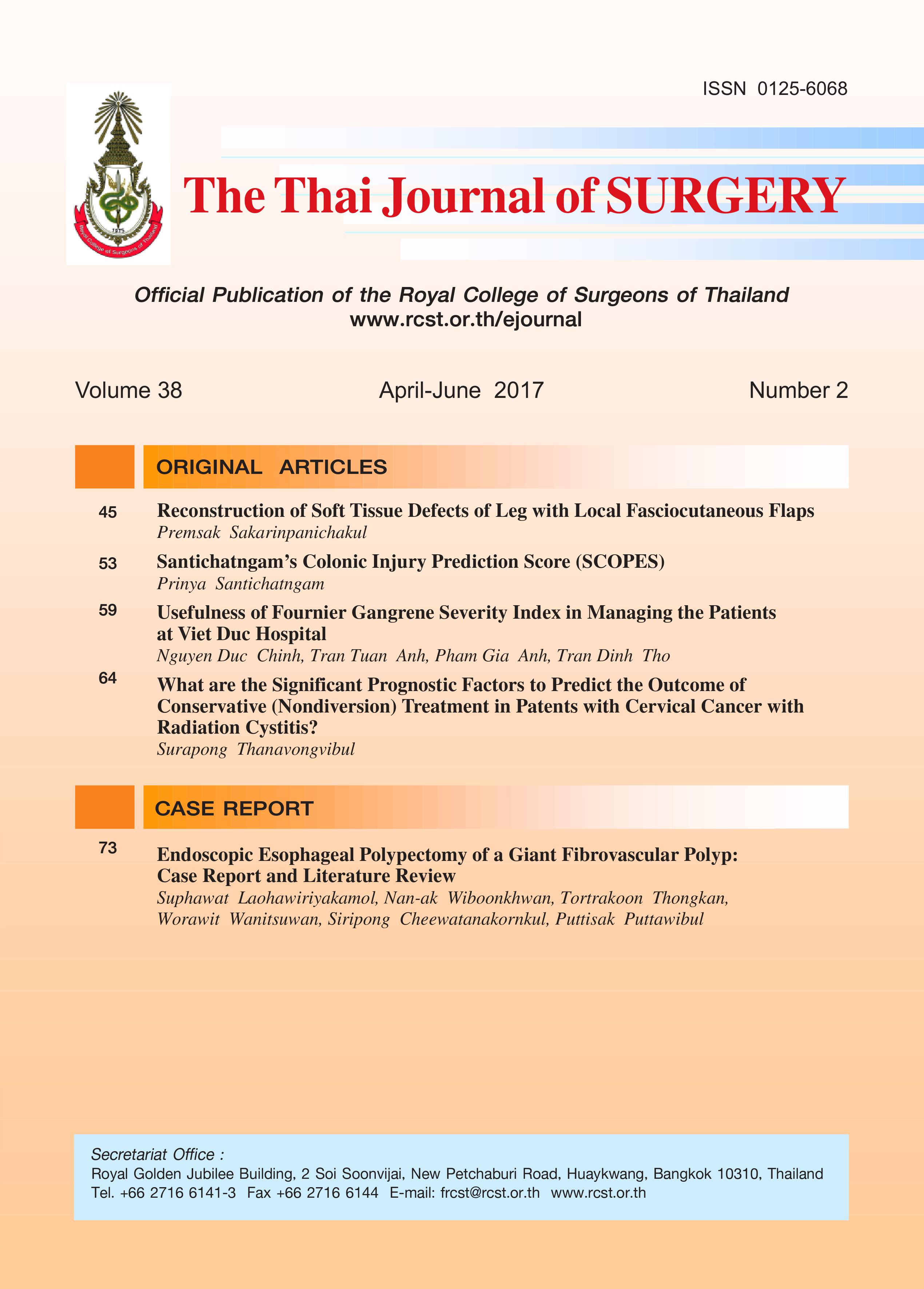Usefulness of Fournier Gangrene Severity Index in Managing the Patients at Viet Duc Hospital
Keywords:
Fournier’s Gangrene, Fournier Gangrene Severity Index, Necrotizing tissuesAbstract
Purpose: Fournier’s gangrene is a life-threatening necrotizing infection of the perineal, perianal, and periurethral tissues that can disseminate even at the subcutaneous tissue of the thigh. In this study, we identified prognostic factors for survival and validated the accuracy of the Fournier’s gangrene severity index (FGSI) in patients with Fournier’s gangrene.
Materials and Methods: We retrospectively reviewed medical records of patients diagnosed with Fournier’s gangrene between 2009 and 2014. FGSI scores were assessed using a receiver operating characteristic curve. An outcome variable of inpatient mortality, univariate analyses were performed by SPSS 18.0.
Results: A total of 27 patients (92.6% male, mean age 50.3 ± 14 years) diagnosed with Fournier’s gangrene met the criteria for review. The overall mortality rate was 14.8% (4 patients). FGSI ≥ 9 was 14.8% vs < 9 was 85.2%. Survival of the group with FGSI ≥ 9 was only 1/4 (25%) versus 22/23 (95.7%) in the group with FGSI < 9. The mean FGSI score for survivors was 3.57 ± 2.57 versus 10.5 ± 2.6 for nonsurvivors (p < 0.001). Using a FGSI score threshold of 9 (sensitivity 71.4%, specificity 90%) there was a 96% survival rate in patients with FGSI of less than 9 and a 46% mortality rate in those with FGSI of 9 or greater (RR = 17.25).
Conclusions and Recommendations: The FGSI remains an objective and simple method to quantify the extent of metabolic aberration at presentation in patients with Fournier’s gangrene. FGSI threshold value of 9 is sensitive and specific for predicting mortality in this patient population and could be used for the clinical managements of FG.
References
2. Dimitrios K, Panagiotis K, Constantinos P, Abhulrahman AA, Anastasios A, Christos R, et al. Fournier’s Gangrene, a Urologic and Surgical Emergency: Presentation of a Multi-Institutional Experience with 45 Cases. Urol Int 2011;86:167-72.
3. Nguyen Duc Chinh, Pham Hai Bang, Pham Van Trung, Pham Vu Hung and Tran Tuan Anh (2012). Remark on management of the patient having Fournier’s gangrene at Viet Duc Hospital. Surg J 2012;(Special issue 1-2-3):149-53.
4. Jaime Ruiz-Tovar, Luis Cordoba, Jose Manuel Devesa. Prognostic factors in Fournier gangrene. Asian J Surg 2012;35:37-41.
5. Malik AM, Sheikh S, Pathan R, Sheikh U. The spectrum of presentation and management of Fournier’s gangrene - an experience of 73 cases. J Pak Med Assoc 2010;60:617-9.
6. Barreda JT, Scheiding MM, Femandez CS, Cuadrado Campana JM, Aguilera JD, et al. Fournier gangrene. A retrospective study of 41 cases. Cirugia Espanola 2010;87: 218-23.
7. Martinschek A, Evers B, Lampl L, Gerngrob H, Schmidt R, Sparwasser C. Prognostic aspects, survival rate, and predisposing risk factors in patients with Fournier’s gangrene and necrotizing soft tissue Infections : evaluation of clinical outcome of 55 patients. Urol Int 2012;89:173-9.
8. Laor E, Palmer LS, Tolia BM, Reid RE, Winter HI. Outcome prediction in patients with Fournier’s gangrene. J Urol 1995;154:89-92.
9. Benjelloun EB, Tarik S, Nadia Y, Abdelmalek O, Khalid M, et al. Fournier’ gangrene : our experience with 50 patients and analysis of factors affecting mortality. World J Emerg Surg 2013,8:13.https://www.wjes.org/content/8/1/13
10. Silvio A, Davorin K, Suad C, Dino P, Zoran R, et al. Fournier’s gangrene: etiology and outcome analysis of 41 patients. Urologia Internationalis 2012;88:289-93.
11. Sorensen MD, Krieger JN, Rivara FP, Klein MB, Wessells H. Fournier’s Gangrene: Management and Mortality Predictors in a Population Based Study. J Urol 2009;82:2742-7.
12. Nguyen Duc Chinh, Tran Tuan Anh. Risk factors affecting to outcome of management of the patients suffering from Fournier’s gangrene. J Pract Med 2014;2:21-4.
13. Tsung-Yen Lin, Chien-Hui O, Tzong-Shin T, Yat-Ching T, Chien-Chen C, et al. Validation and simplification of Fournier’s gangrene severity index. Intern J Urol 2014;21:696-701.
14. Cem Ozden Yeniyol, Suelozgen T, Arslan M and Ayder AR. Fournier’s gangrene: experience with 25 patients and use of Fournier’s gangrene severity index score. Urology 2004;64:218-22.
15. Bulent E, Altug T, Volkan H, Husnu T, Abdulkadir Y, Bulent A, et al. Fournier’s gangrene: overview of prognostic factors and definition of new prognostic parameter. Urology 2010;75:1193-8.
16. Korkut M, Icoz G, Dayangac M, Akgun E, Yeniyay L, Erdogan O, et al. Outcome analysis in patients with Fournier’s gangrene: Report of 45 cases. Dis Colon Rectum 2003;46:649-52.
17. Unalp HR, Kamer E, Derici H, Atahan K, Balci U, Demirdiven C, et al. Fournier’s gangrene: Evaluation of 68 patients and analysis of prognostic variables. J Postgrad Med. 2008;54:102-5.
18. Saturnino LM, Alberto B, Carlos DC, Enrique B, Fernando JC. Evalution of a severity score to predict the prognosis of Fournier’s gangrene. BJU 2009;106:373-5.
19. Yilmazlar T, Ozturk E, Ozguc H, Ercan I, Vuruskan H, et al. Fournier’s gangrene: an analysis of 80 patients and a novel scoring system. Tech Coloproctol 2010;14:217-23.
20. Roghmann F, Christian VB, Bjorn L, Andreas H, Juri P, Joachim N. Is there a need for the Fournier’s gangrene severity index? Comparison of scroring systems for outcome prediction in patients with Fournier’s gangrene. BJU 2012;110:1359-65.
21. Ik Yong Kim. Gangrene: The Prognostic Factors and Validation of Severity Index in Fournier’s Gangrene - Current Concepts and Management Options, Dr.Alexander vitin (Ed.), 2011. ISBN: 978-953-307-386-6, InTech Available from: https://www.intechopen.com/books/gangrene-currentconcepts-and-management-options/gangrene-theprognostic-factors-and-validation-of-severity-index-infournier-s-gangrene
22. Oscar Estrada Ferrer. Fournier’s gangrene - Medical and Surgical Considerations, Gangrene - Current Concepts and Management Options, Dr. Alexander Vitin (Ed). 2011. ISBN: 978-953-307-386-6, InTech, Available from: https://www.intechopen.com/books/gangrene-current-concepts-andmanagement-options/fournier-s-gangrene-medical-andsurgical-considerations
23. Alejandro GM, Juan Atianio AL, Jesus DG, Rafael MM, Laura SG. Fournier’s gangrene: our experience in 5 years, bibliographic review and assessment of the Fournier’s gangrene severity index. Arch Esp Urol 2009;62:532-40.
Downloads
Published
How to Cite
Issue
Section
License
Articles must be contributed solely to The Thai Journal of Surgery and when published become the property of the Royal College of Surgeons of Thailand. The Royal College of Surgeons of Thailand reserves copyright on all published materials and such materials may not be reproduced in any form without the written permission.



